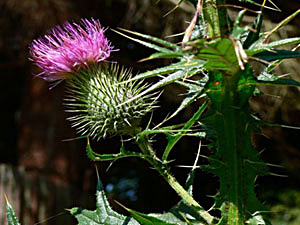
medicinal herbs
Common Thistle
Cirsium vulgare

Herb: Common Thistle
Latin name: Cirsium vulgare
Synonyms: Carduus lanceolatus, Cirsium lanceolatum
Family: Compositae
Medicinal use of Common Thistle:
The roots have been used as a poultice and a decoction of the plant used as a poultice on sore jaws. A hot infusion of the whole plant has been used as a herbal steam for treating rheumatic joints. A decoction of the whole plant has been used both internally and externally to treat bleeding piles.Description of the plant:

Plant:
Biennial
Height:
2 m(6 1/2 foot)
Habitat of the herb:
Fields, waysides, gardens and waste places to 600 metres.Edible parts of Common Thistle:
Root - cooked. A taste somewhat like a Jerusalem artichoke, but not as nice. A rather bland flavour, the root is best used mixed with other vegetables. The root can be dried and stored for later use. The root is rich in inulin, a starch that cannot be digested by humans. This starch thus passes straight through the digestive system and, in some people, ferments to produce flatulence. Young flower stems - cooked and used as a vegetable. Young leaves can be soaked overnight in salt water and then cooked and eaten. Another report says that they can be used in salads. The taste is rather bland but the prickles need to be removed from the leaves before the leaves can be eaten - not only is this a rather fiddly operation but very little edible matter remains. Flower buds - cooked. Used like globe artichokes, but smaller and even more fiddly. The dried flowers are a rennet substitute for curdling plant milks. Seed - occasionally eaten roasted.Other uses of the herb:
A fibre obtained from the inner bark is used in making paper. The fibre is about 0.9mm long. The stems are harvested in late summer, the leaves removed and the stems steamed until the fibres can be stripped off. The fibres are cooked with lye for two hours and then put in a ball mill for 3 hours. The resulting paper is a light brown tan. The seed of all species of thistles yields a good oil by expression. No details of potential yields etc are given. The down makes an excellent tinder that is easily lit by a spark from a flint.Propagation of Common Thistle:
Seed - sow early spring or autumn in situ. Germination usually takes place within 2 - 8 weeks at 20°C. A pernicious weed, it really needs no encouragement from us.Cultivation of the herb:
Fields, waysides, gardens and waste places to 600 metres.Known hazards of Cirsium vulgare:
None knownPlant information taken from the Plants For A Future.
